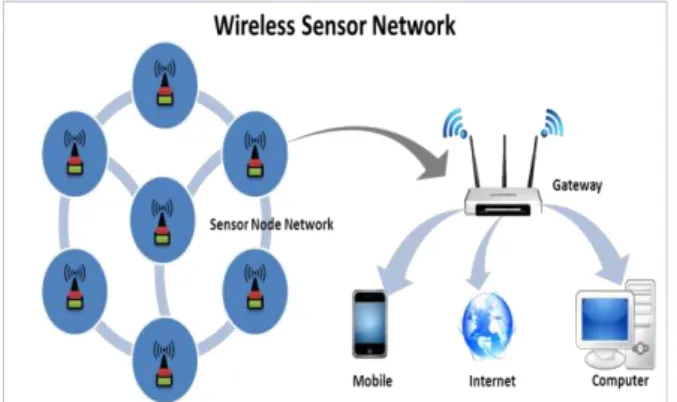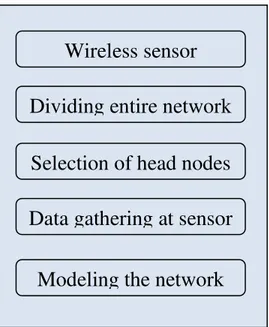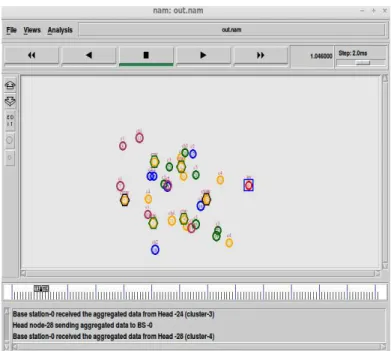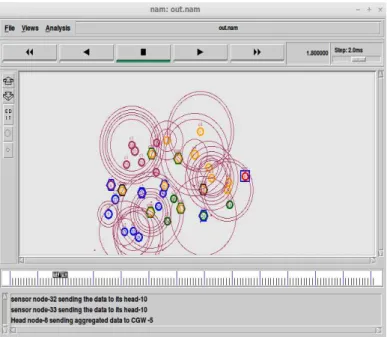American Journal of Engineering Research (AJER)
2015
American Journal of Engineering Research (AJER)
e-ISSN: 2320-0847 p-ISSN : 2320-0936
Volume-4, Issue-9, pp-205-211
www.ajer.org
Research Paper Open Access
w w w . a j e r . o r g
Page 205
Data-Collection using Clustering Approach in Wireless Sensor
Network Design based on Heuristic Algorithms
1
Vishwaja B,
2Mrs. Geetha
1
M.TECH in Computer science CMR Institute of technology Bangalore, India
2Assistant professor CMR Institute of technology Bangalore, India
Abstract
—
Data-gathering wireless sensor networks (WSNs) are operated unattended over long time horizons to collect data in several applications such as those in climate monitoring and a variety of ecological studies. Typically, sensors have limited energy (e.g., an on-board battery) and are subject to the elements in the terrain. In-network operations, which largely involve periodically changing network flow decisions to prolong the network lifetime, are managed remotely, and the collected data are retrieved by a user via internet. In this paper, we study an integrated topology control and routing problem in cluster-based WSNs. To prolong network lifetime via efficient use of the limited energy at the sensors, we adopt a hierarchical network structure with multiple sinks at which the data collected by the sensors are gathered through the cluster heads (CHs). We consider a Particle Swarm Optimization model to optimally determine the sink and CH locations as well as the data flow in the network. Our model effectively utilizes both the position and the energy-level aspects of the sensors while selecting the CHs and avoids the highest-energy sensors or the sensors that are well-positioned sensors with respect to sinks being selected as CHs repeatedly in successive periodsKeywords
—Wireless sensor networks, Data gathering, energy , Network lifetime, cluster head.I.
INTRODUCTION
There is a rapid development of low cost, multifunctional and low power sensors through the recent advances in, embedded microprocessors, Wireless sensor networking, integration of micro electromechanical systems (MEMS), and nanotechnology. Sensors of very small size are capable of sensing, processing data and communicating with each other or with the data sinks. Wireless sensor network (WSN) is formed by the group of sensors which are communicating in a wireless medium in order to gather the data and transmit it to a user (sinks).The main purpose of Wireless sensor network applications is to monitor and collect data by the sensors and to transmit the data to the sinks. Wireless sensor networks are categorized into four types as time-driven, sink-initiated, event-driven and hybrid in terms of data delivery scheme. In the time-driven model, the sensors swill send the data periodically to the sink by sensing the data continuously at a pre specified rate. For event-driven and sink-initiated models, when a certain event occurs or when a request is initiated by the sink, then the sensors report to the sink. These models are well suited to time-critical applications. A hybrid model is the combination of the all the above three methods.
w w w . a j e r . o r g
Page 206
Wireless sensor network as shown in fig 1 gives an opportunity for ecological monitoring which was not possible before due to infeasibility of in-person attendance in data collection and the remoteness of areas of interest. Wireless sensor network make possible of eco-monitoring and also facilitates more frequent data collection. Wireless sensor network operations have the following framework. First a set of sensors with limited energy resource are equipped and as well as with the capabilities of sensing, processing and communication are deployed in a geographical region. Sensors forward the data collected by them to the designated sensors which are called as cluster heads ( CHs), which aggregate their received data through some processing. Cluster Heads then forward the data to sinks which are deployed at specific locations, either directly or through other Cluster heads. Determination of the cluster Head and sink locations is the design of the network, while routing of data from the sensors to the sinks in the network refers to the operation decisionsNetwork lifetime which is defined as the time between two sensor deployments is one of the main concerns in network design and operation. Having less number of operational sensors with enough remaining energy in the network may be one of the reason for the sensor redeployments. The lifetime is divided into periods which are of uniform length and each period is made with network design and operations decisions considering that the number of periods in deployment cycle is maximized.
The two fundamental problems in effective design and operation of Wireless sensor network are topology control and routing. The energy efficiency and computation-communication trade off are some design specific/ operation attributes which underlines the relation between the decisions and their relation to network lifetime. Energy efficiency is the main concern because each sensor has finite and nonrenewable energy resource. Communication-computation tradeoff means the fact that the energy consumed by the communication is more than the computations performed on board a sensor.
Despite the innumerable applications of WSNs, these networks have several restrictions, e.g., limited energy supply, limited computing power, and limited bandwidth of the wireless links connecting sensor nodes. One of the main design goals of WSNs is to carry out data communication while trying to prolong the lifetime of the network and prevent connectivity degradation by employing aggressive energy management techniques. The design of routing protocols in WSNs is influenced by many challenging factors. These factors must be overcome before efficient communication can be achieved in WSNs. In the following, we summarize some of the routing challenges and design issues that affect routing process in WSNs.
• Node deployments: Node deployment in WSNs is application dependent and affects the performance of
the routing protocol. The deployment can be either deterministic or randomized.
• Energy consumption without losing accuracy: Sensor nodes can use up their limited supply of energy
performing computations and transmitting information in a wireless environment.
• Data Reporting Model: Data sensing and reporting in WSNs is dependent on the application and the time
criticality of the data reporting. Data reporting can be categorized as either time-driven (continuous), event-driven, query-event-driven, and hybrid.
• Node/Link Heterogeneity: In many studies, all sensor nodes were assumed to be homogeneous, i.e.,
having equal capacity in terms of computation, communication, and power. However, depending on the application a sensor node can have different role or capability.
• Scalability: The number of sensor nodes deployed in the sensing area may be in the order of hundreds or
thousands, or more. Any routing scheme must be able to work with this huge number of sensor nodes.
• Coverage: In WSNs, each sensor node obtains a certain view of the environment. A given sensor's view of
the environment is limited both in range and in accuracy; it can only cover a limited physical area of the environment. Hence, area coverage is also an important design parameter in WSNs.
• Data Aggregation: Since sensor nodes may generate significant redundant data, similar packets from
multiple nodes can be aggregated so that the number of transmissions is reduced. Data aggregation is the combination of data from different sources according to a certain aggregation function, e.g., duplicate suppression, minima, maxima and average.
• Quality of Service: In some applications, data should be delivered within a certain period of time from the
moment it is sensed, otherwise the data will be useless. Therefore bounded latency for data delivery is another condition for time-constrained applications. However, in many applications, conservation of energy, which is directly related to network lifetime, is considered relatively more important than the quality of data sent.
Applications of Wireless Sensor Networks
Area monitoring
Area monitoring is a common application of WSNs. In area monitoring, the WSN is deployed over a region where some phenomenon is to be monitored.
Air quality monitoring
w w w . a j e r . o r g
Page 207
Forest fire detection
A network of Sensor Nodes can be installed in a forest to detect when a fire has started. The nodes can be equipped with sensors to measure temperature, humidity and gases which are produced by fire in the trees or vegetation.
Natural disaster prevention
Wireless sensor networks can effectively act to prevent the consequences of natural disasters, like floods.
Machine health monitoring
Wireless sensor networks have been developed for machinery condition-based maintenance (CBM) as they offer significant cost savings and enable new functionality. In wired systems, the installation of enough sensors is often limited by the cost of wiring.
Industrial sense and control applications
In recent research a vast number of wireless sensor network communication protocols have been developed. While previous research was primarily focused on power awareness, more recent research have begun to consider a wider range of aspects, such as wireless link reliability, real-time capabilities, or quality-of-service.
Water/Waste water monitoring
Monitoring the quality and level of water includes many activities such as checking the quality of underground or surface water and ensuring a country’s water infrastructure for the benefit of both human and animal. The cluster based algorithms could be used for partitioning the sensor nodes into subgroups for task subdivision or energy management. A survey on clustering algorithms for WSNs can be found in [2].
Based on the set of sensors deployed and which are available at the beginning of a period, determining the sinks and Cluster Heads to employ and flow of data from sensors to sinks through Cluster Heads in the specified period is considered as the problem definition. Hence, the average usage of the energy and the variation in distributing the remaining energy in the network is minimized and the adoption of high-energy sensors as Cluster Heads is encouraged. There is a assumption that any sensor can be a Cluster Head while looking that whether there are special high-energy sensors deployed for this role.
The main aim of the project work is to optimize the energy possessed by each sensor node in wireless Sensor Networks that is to increase the lifetime of the sensor nodes deployed in various regions
II.
RELATED
WORK
Grouping the sensors into clusters known as clustering has been shown effective in prolonging sensor network lifetime in the literature. The basic idea is organising the wireless sensor network into a set of clusters, sensors transmit the collected data to their Cluster Heads within each cluster. The received data is aggregated by each cluster head and forwards to the sink either directly or through other Cluster Heads.
There are three ways of benefits in terms of energy efficiency:
1) A multi-hop sensor-to-sink data transfer scheme that eliminates the quick energy drainage at the sensors which are away from the sink can be achieved by the hierarchical structure; 2) To reduce the redundancy of the data so that communication energy savings are realized, Cluster Heads will aggregate the data 3) Energy consumption can be balanced by reassigning the CHs and the sinks and adjusting the routing in the network by re-clustering in uniform time intervals.
Heinzelman et al. [18] develop a cluster-based data aggregating routing protocol Low Energy Adaptive Clustering Hierarchy (LEACH). In LEACH, a single-hop Cluster head-to-sink connection is assumed and the randomized rotation of Cluster Heads is adopted to ensure a balanced energy consumption.
w w w . a j e r . o r g
Page 208
Disadvantage
These assumptions may not provide guarantee to network connectivity.
Younis and Fahmy [19] proposed a hybrid energy-efficient distributed clustering routing (HEED) protocol where the probabilistic selection of the cluster head is based on their remaining energy and the addition of sensors into the clusters such that the communication cost is minimized. A multihop connection between the CHs and to the sink is assumed in HEED.
HEED (Hybrid Energy-Efficient Distributed clustering), which has four primary goals: (i) prolonging network lifetime by distributing energy consumption, (ii) terminating the clustering process within a constant number of iterations/steps, (iii) minimizing control overhead (to be linear in the number of nodes), and (iv) producing well-distributed cluster heads and compact clusters. HEED does not make any assumptions about the distribution or density of nodes, or about node capabilities.
Liu et al. [20] suggested a distributed energy-efficient protocol known as EAP. In EAP, the selection of the cluster head is based on its ratio of the remaining energy to the average remaining energy of all the neighbor sensors within its cluster range. The Cluster heads are chosen based on a sensors’ own remaining energy in EAP. To extend the network lifetime, the idea of “intracluster coverage” which allows a partial set of sensors to be active within clusters while maintaining an expected coverage is introduced by EAP.
III. PROPOSED
SYSTEM
The Proposed System is a System which uses the particle swarm optimization heuristic algorithm to select the Cluster heads in various clusters formed by the large number of nodes. The cluster heads are selected based on the factors such as Energy, Density and Mobility. The node with the highest energy, density and lowest mobility is elected as the cluster head for that particular cluster and the nodes in that cluster gets informed about the cluster head. The nodes will collect the data from the deployed region and forward the data to the cluster head instead of base station and further the data is aggregated by the cluster head from all the nodes of that cluster and forwarded to the base station through the Gateways. The following are some of the advantages of the proposed system.
• Simple to understand and implement • Convergence at the faster rate
• Adaptive towards the failure of any sensor node in the network.
A. System Architecture
The structure and behavior of a system are defined in the System Architecture. An architecture description is organized in a way to support reasoning about the system’s structural properties and it provides a formal description of a system. It provides an overview from which products can be produced, and it defines the system components or building blocks and the systems developed, which will work together in the implementation of the overall system. The System architecture is shown below.
Fig 2 Architecture
Wireless sensor
network establishment
Dividing entire network
into clusters
Selection of head nodes
based on remaining
Data gathering at sensor
level and aggregation at
w w w . a j e r . o r g
Page 209
Main Modules are: Network setup
Clustering
Selection of cluster head
Data transmission to Base Station
Network Setup
Large numbers of sensors are placed in the wireless sensor networks at remote places in order to gather the data from the clients to transfer to the destinations known as sinks. The sensor nodes are provided with the limited battery where its energy drains up to send the data to destination. All the nodes, Cluster heads and the sinks should have proper communication through the network.
Clustering
As there are large number of sensors with limited energy, in order to have the energy efficiency the sensor nodes are divided into various clusters based on the energy obtained by them in order to select any one node from each cluster as cluster head to perform the data forwarding function on behalf of involvement of all nodes.
Selection of Cluster Head
In order to optimize the energy among the nodes the nodes are grouped into various clusters. In Clusters the energy obtained by the nodes are compared with each other node using the particle swarm optimization technique. The node with the highest energy is elected as the cluster head of that particular cluster. The cluster head gathers all the data from its cluster’s nodes, aggregates and forwards to the sink nodes through the network.
Transmission of Data to Base Station
Sink Nodes are the destination nodes which are placed at a suitable distance from the cluster heads. The sink nodes receives the data from the clusters heads and acknowledges for receiving the data where there is no involvement of each node with the sink node. Hence the energy obtained bu the nodes are effectively optimized.
IV. SIMULATION RESULTS Scenario 1:
Fig 3 Communication between nodes and base station
w w w . a j e r . o r g
Page 210
Scenario 2:Fig 4 Communication between node and cluster head
The above scenario shows sending message between sensor node 32 to cluster head 10 Scenario 3:
Fig 6 Packet drop The above scenario shows the drop of packet graph
V.
RESULTS
AND
CONCLUSION
The Proposed System is a System which uses the particle swarm optimization heuristic algorithm to select the Cluster heads in various clusters formed by the large number of nodes. The cluster heads are selected based on the factors such as Energy, Density and Mobility. The node with the highest energy, density and lowest mobility is elected as the cluster head for that particular cluster and the nodes in that cluster gets informed about the cluster head. The nodes will collect the data from the deployed region and forward the data to the cluster head instead of base station and further the data is aggregated by the cluster head from all the nodes of that cluster and forwarded to the base station through the Gateways. The following are some of the advantages of the proposed system, Simple to understand and implement, Convergence at the faster rate, Adaptive towards the failure of any sensor node in the network. In future scope this system can also be implemented with ant bee colony technology.
Acknowledgment
w w w . a j e r . o r g
Page 211
REFERENCES
[1] C. Y. Chong and S. P. Kumar, “Sensor networks: Evolution, opportunities, and challenges,” Proc. IEEE, vol. 91, no. 8, pp. 1247–1256, Aug. 2003.
[2] K. Sohraby, D. Minoli, and T. F. Znati, Wireless Sensor Networks: Technology, Protocols, and Applications. Hoboken, NJ, USA:Wiley,2007.
[3] S. Tilak, N. B. Abu-Ghazaleh, and W. R. Heinzelman, “A taxonomy of wireless micro-sensor network models,” Mobile Comput. Commun.Rev., vol. 6, no. 2, pp. 28–36, 2002.
[4] J. Porter, P. Arzberger, H. Braun, P. Bryant, S. Gage, T. Hansen, P. Hanson, C. Lin, F. Lin, T. Kratz, W. Michener, S. Shapiro, and T. Williams, “Wireless sensor networks for ecology,” BioScience, vol. 55, pp. 561–572, 2005.
[5] A. Cerpa, J. Elson, D. Estrin, L. Girod, M. Hamilton, and J. Zhao, “Habitat monitoring: Application driver for wireless communications technology,” in Proc. ACM SIGCOMM Workshop Data Commun.Latin Amer. Carib., 2001, pp. 20–41. [6] A. Mainwaring, J. Polastre, R. Szewczyk, and D. Culler, “Wirelesssensor networks for habitat monitoring,” in Proc. 1st ACM
WSNA, 2002, pp. 88–97.
[7] E. Biagioni and K. Bridges, “The application of remote sensor technology to assist the recovery of rare and endangered species,”
Int. J.High Perform. Comput. Appl., vol. 16, no. 3, pp. 315–324, 2002.
[8] S. L. Collins, L. M. A. Bettencourt, A. Hagberg, R. F. Brown, D. I. Moore, G. Bonito, K. A. Delin, S. P. Jackson, D. W. Johnson, S. C. Burleigh, R. R. Woodrow, and J. M. McAuley, “New opportunitiesin ecological sensing using wireless sensor networks,”
Frontiers Ecol.Environ., vol. 4, no. 8, pp. 402–407, 2006.
[9] K.Martinez, J. K. Hart, and R. Ong, “Environmental sensor networks,”Computer, vol. 37, pp. 50–56, 2004.
[10] F. Al-Turjman, H. Hassanein, and M. Ibnkahla, “Connectivity optimization with realistic lifetime constraints for node placement in environmental monitoring,” in Proc. 34th IEEE LCN, Oct. 2009, pp. 617–624.
[11] F. Al-Turjman, H. Hassanein, and M. Ibnkahla, “Connectivity optimization for wireless sensor networks applied to forest monitoring,” in Proc. IEEE ICC, Jun. 2009, pp. 1–6.
[12] J. K. Hart and K. Martinez, “Environmental sensor networks: A revolution in the earth system science?,” Earth-Sci. Rev., vol. 78, no. 3–4, pp. 177–191, 2006.



